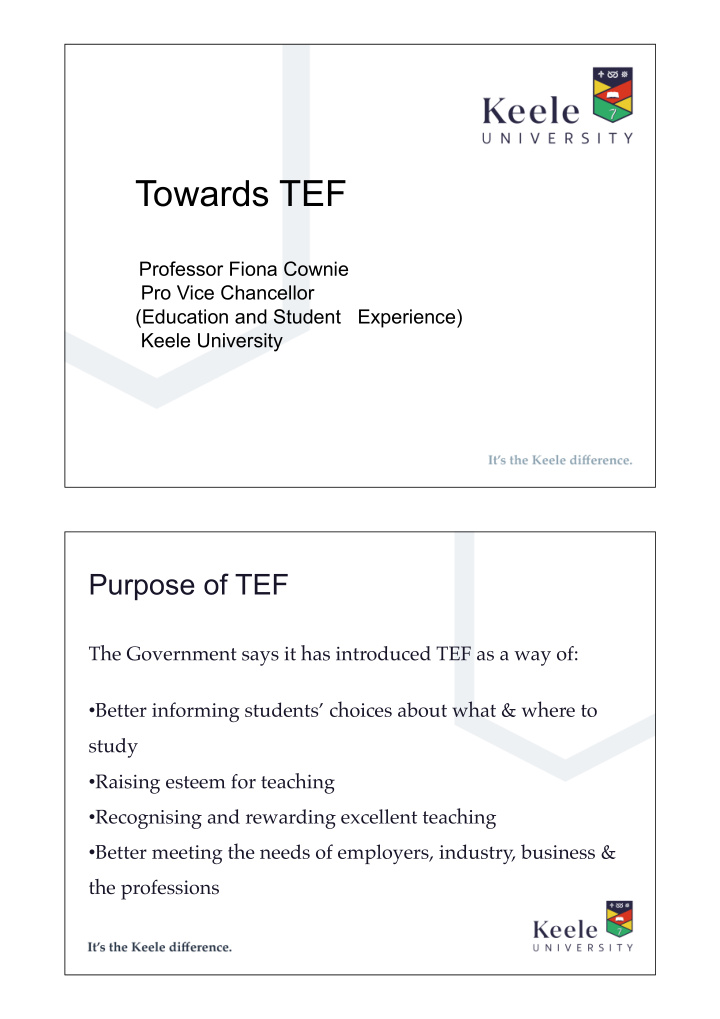



Towards TEF Professor Fiona Cownie Pro Vice Chancellor (Education and Student Experience) Keele University Purpose of TEF The Government says it has introduced TEF as a way of: • Better informing students’ choices about what & where to study • Raising esteem for teaching • Recognising and rewarding excellent teaching • Better meeting the needs of employers, industry, business & the professions
The TEF: Key Features • Second year of the scheme = “TEF2” (TEF1 = QAA review) • Two main components to the submission - Data metrics provided by HEFCE - Narrative submission provided by university • Three possible outcomes of the TEF: Gold, Silver and Bronze • Link to fee rises The Metrics – ‘Core’ and ‘Split’ Core metrics = Teaching on my course (NSS Q 1-4 ) Assessment and Feedback (NSS Q5-9 ) Academic Support (NSS Q10-12) Non-Continuation (HESA & ILR Data ) Employment or Further Study (DLHE 6 months p.g.) Highly skilled employment or further study (DLHE)
Split Metrics • Year of Study • Level of Study (first degree or � other undergraduate) • Age (young / mature) • Disadvantaged (POLAR) • Ethnicity • Disabled • Sex Significance Flags • Data is benchmarked to allow meaningful comparisons between institutions by taking into account the different mix of students at each provider. • Results that are significantly different from benchmark are highlighted. • 2 percentage points above benchmark = one flag • 3+ percentage points above benchmark = a double flag • Similarly, if below benchmark (one or two negative flags)
The Narrative Submission (15 sides) Purpose = to enable the provider to: • Add additional context e.g. mission • Support or explain performance against the core and split metrics • Put forward evidence against the assessment criteria • Further explore performance for specific student groups based on split metrics Assessment Criteria • Teaching Quality • Learning Environment • Student Outcomes & Learning Gain • TEF Descriptors (bronze, silver, gold) • Gold = consistently outstanding & of the highest quality • Silver = high quality and significantly and consistently exceeds baseline quality threshold • Bronze = provision is of satisfactory quality
Assessment • Assessors plus panel • Narrative must demonstrate the impact & effectiveness of teaching on student experience and the outcomes they achieve. • Wherever possible, impact should be demonstrated empirically. • No prior knowledge or external evidence can be taken into account. • Teaching & learning excellence must be demonstrated across an institution’s entire provision (no pockets of excellence). • Evidence should normally be from the last 3 years. (Not future promises) Beyond TEF 2 • TEF will become an annual sector exercise • TEF2 awards will be valid for up to 3 years • For TEF3 – fee differentiation between Bronze and Silver/Gold • Intention to pilot subject-level TEF in 2017/18 - but fees will not vary by subject • Potential for PGT-level TEF in 2018/19 • TEF metrics will evolve – e.g. learning gain
Discipline-level TEF • Very little information • JACs codes? REF categories? Humanities, Social Sciences, Natural Sciences? • Likely to have to show excellence across a group of disciplines • Actual TEF (as opposed to pilot) not till yr 5 of the scheme Things to watch out for: • NSS is changing • DLHE is also under review and expected to change • HEFCE is piloting research on ‘learning gain’ for possible future inclusion. • The data is based on a 3 year average – the time lag between you taking action and that being reflected in the data is great. • Obtaining the data you need can be tricky
Useful Documents • HEFCE Teaching Excellence Framework Year Two Additional Guidance (October 2016/32) • HEFCE Teaching Excellence Framework Year Two supplementary technical guidance for panel members and assessors (December 2016/32a) • HEA Guidance on the Teaching Excellence Framework
Recommend
More recommend